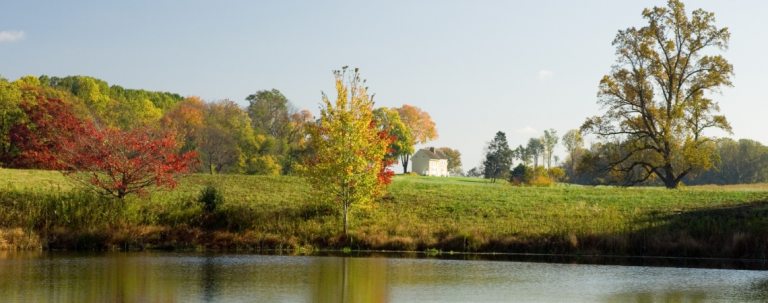Undoubtedly the world’s most valuable resource, water is an integral part of both the Gardens’ beauty and landscape. At Longwood Gardens, we are committed to protecting our water supply through innovative practices and sustainable technologies that not only preserve this precious resource but also inspire others to do the same.
From the watersheds that tell the story of how water works in our landscapes to our adoption of advanced technologies, we prioritize the responsible care and management of this natural resource. By embracing a One Water approach that recognizes all water as valuable, we reuse water multiple times to reduce demand on groundwater and enhance sustainability.
Watershed Vitality
A watershed is a community of the land, bound together by the water that courses through it. From rain and melting snow through groundwater, creek and stream, to river, estuary, bay, and ocean, water is the lifeblood of the earth. A watershed includes the network of arteries through which water flows, as well as the land that it nourishes.
On the grounds of Longwood, water runs clean, clear, and cold from springs and lakes before winding its way through tributaries of the Red Clay and Brandywine Creeks. Wide riparian buffers—streamside plantings of native trees and shrubs—work to filter storm runoff to keep the water free of pollutants and excess nutrients. Research by the Stroud Water Research Center recommends buffers of nearly one hundred feet for adequate stream protection.
The roots of streamside trees also prevent bank erosion, keeping the streams wide and clear of sediment. The shade of their canopy keeps the water cool and allows just the right amount of light to filter through to the native algae that thrive in shallow streams. The algae is then grazed upon by insects that form the bulk of the biomass that feeds other invertebrates, fish, and the young of most birds. These practices align with our broader water conservation efforts, including our use of reclaimed water and stormwater harvesting to protect and enhance watershed health.
Hourglass Lake
Hourglass Lake, originally called Wild Pond, was created as a water supply and for fire protection in 1959. Its placement coincided with a wet, marshy area and stream course, creating a naturalistic water feature. Wetlands are established around the periphery of the lake today and are a thriving habitat within the Meadow Garden. Though originally created through human intervention, the lakes are gradually being reclaimed by nature but are still guided by the human hand. This feature also supports our One Water journey by contributing to the cycle of water management and habitat restoration.
For more information:
Water Consumption
We employ advanced technologies and proven techniques to reduce our overall water usage while conserving available resources. Among the technologies used to reduce water consumption in the Gardens are timer and drip irrigation systems and UgMO—a novel technology that measures water content in the ground.
Our Garden Irrigation System (GIS), implemented in 2003, takes water conservation a step further by reusing treated effluent for outdoor irrigation, saving an estimated 3 million gallons of groundwater annually. The integration of reclaimed water systems in the flush toilets for The Grove, new restrooms in the Conservatory District, and Beer Garden further reduces our groundwater dependence by approximately 1 million gallons annually. Additionally, stormwater harvesting from the new West Conservatory and The Grove captures rainwater for irrigation and water features, saving another estimated 0.7 to 1 million gallons annually.
When irrigation systems break, they are quickly repaired to minimize the amount of water wasted. In times of drought, we adhere to an established drought management program that outlines steps for reducing water consumption. We also utilize soil moisture monitoring to avoid overwatering, reduce lawn mowing frequency, and increase grass height to improve drought resistance.
Re-energizing Our Water Supply
Through our One Water journey, we have redefined how we manage water at Longwood Gardens. Starting in the 1980s, we upgraded our onsite sewage treatment plant to allow treated effluent to be sprayed over a 40-acre spray field, returning water to the aquifer instead of discharging it off-site. This system has been in place since 1987 and has eliminated the need for creek discharge.
The next significant stride came with the GIS, further treating effluent for irrigation use and achieving substantial groundwater savings over two decades. Most recently, improvements to the sewage treatment plant allow all water to undergo tertiary treatment for unrestricted outdoor irrigation use.
In conjunction with the Longwood Reimagined project, dedicated plumbing now enables reclaimed water to be used for toilet flushing, while stormwater harvesting systems filter and disinfect rainwater for irrigation, water features, and flush toilets. Together, these initiatives underscore our commitment to sustainable water practices and demonstrate the effectiveness of the One Water approach.
